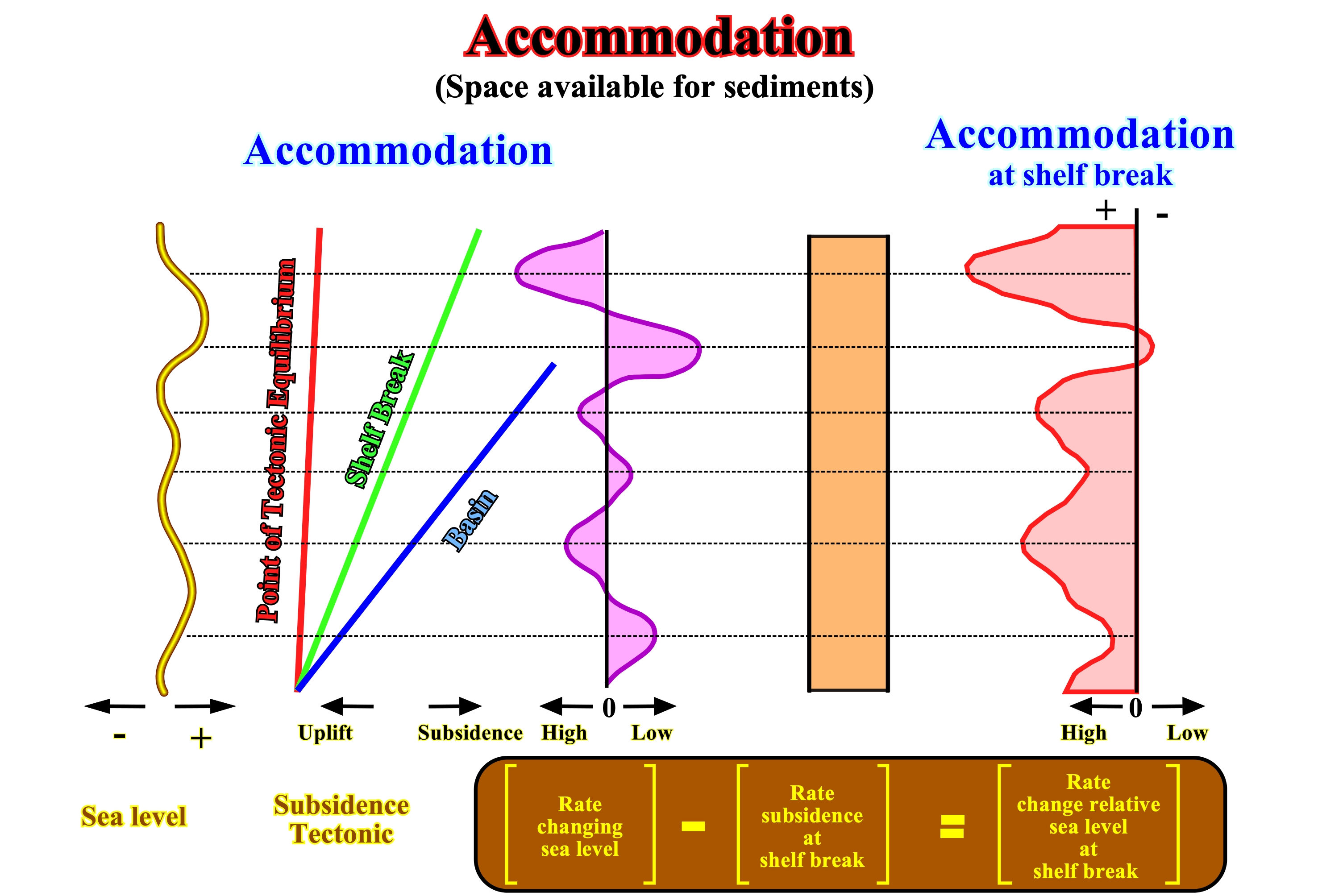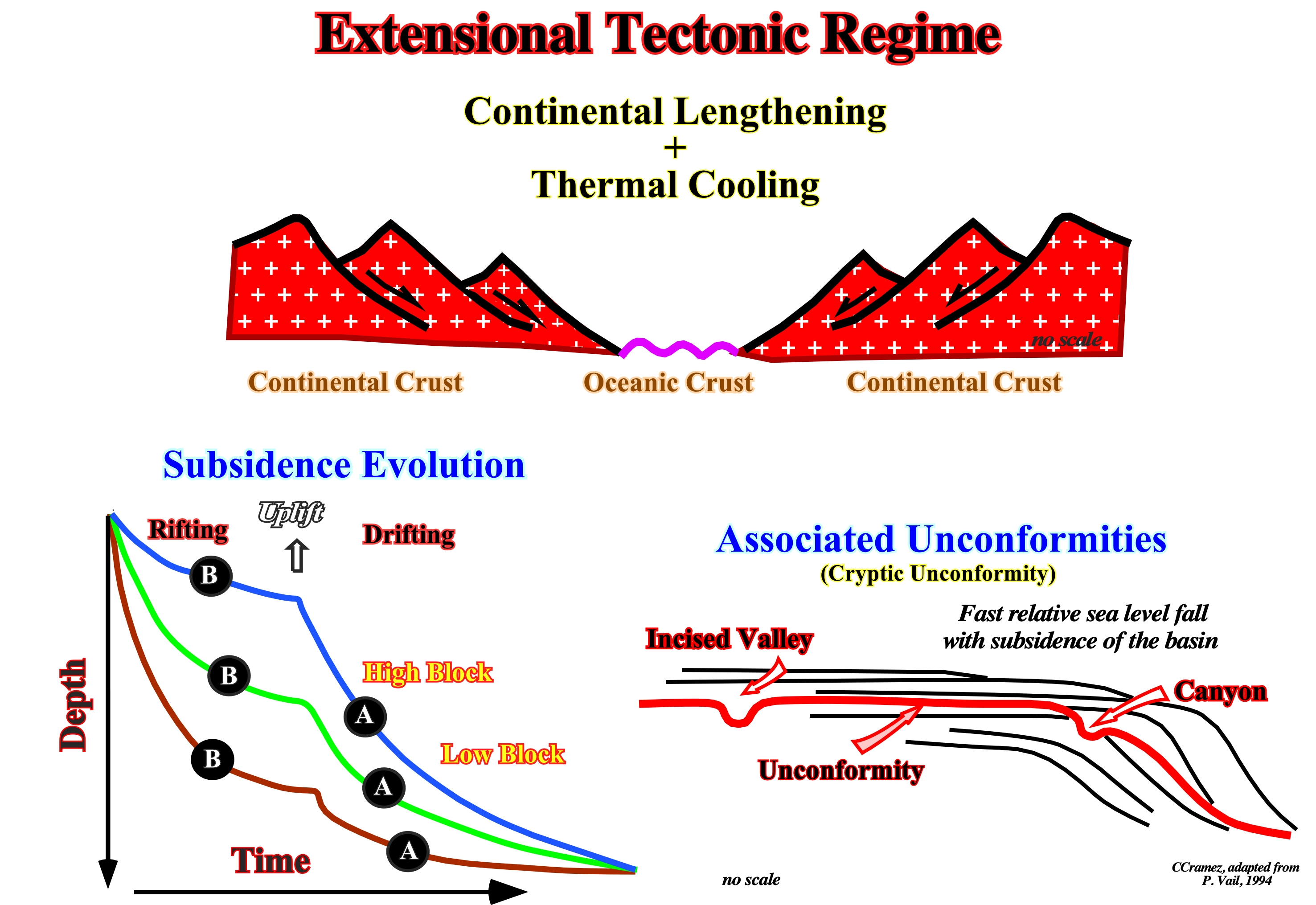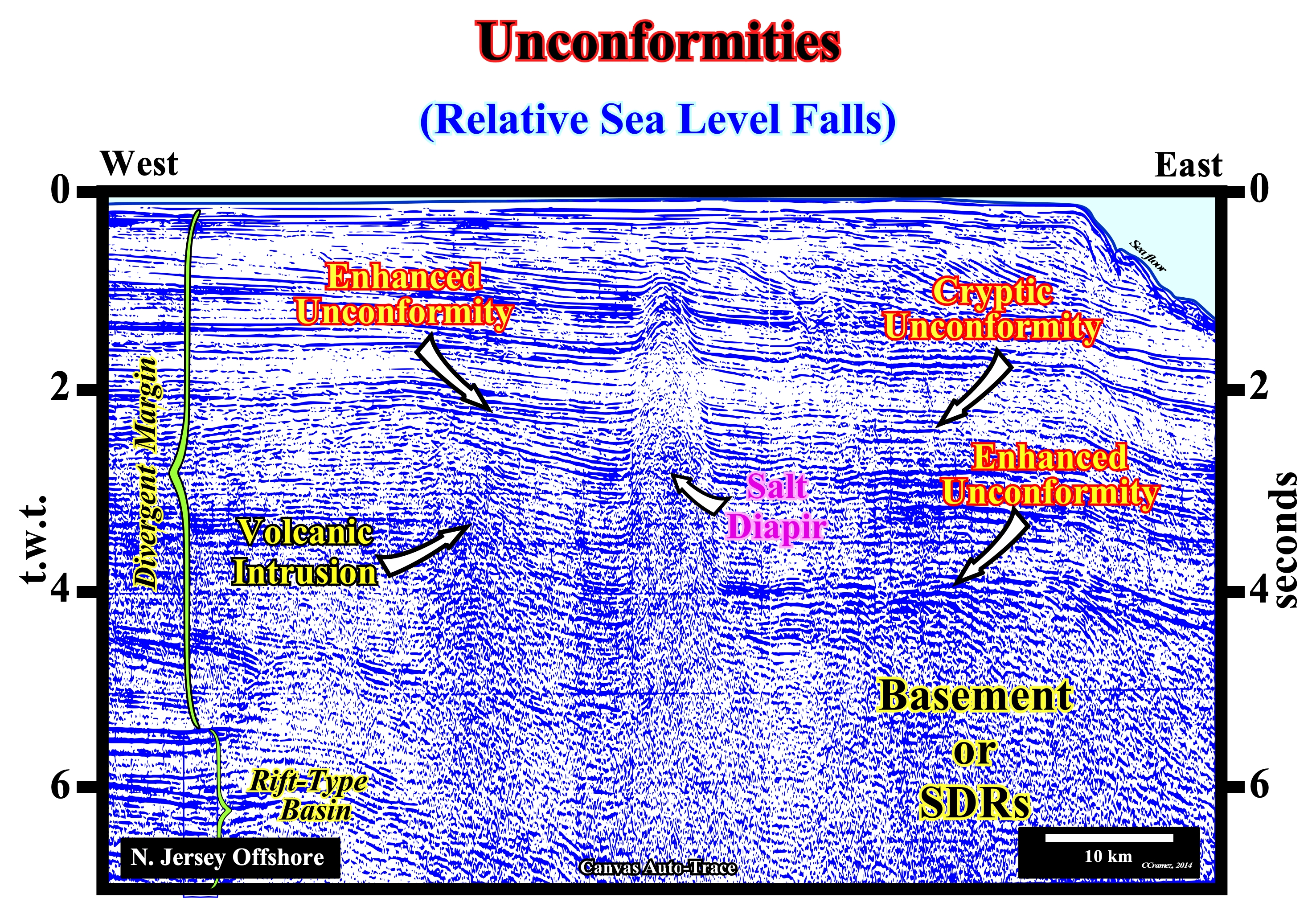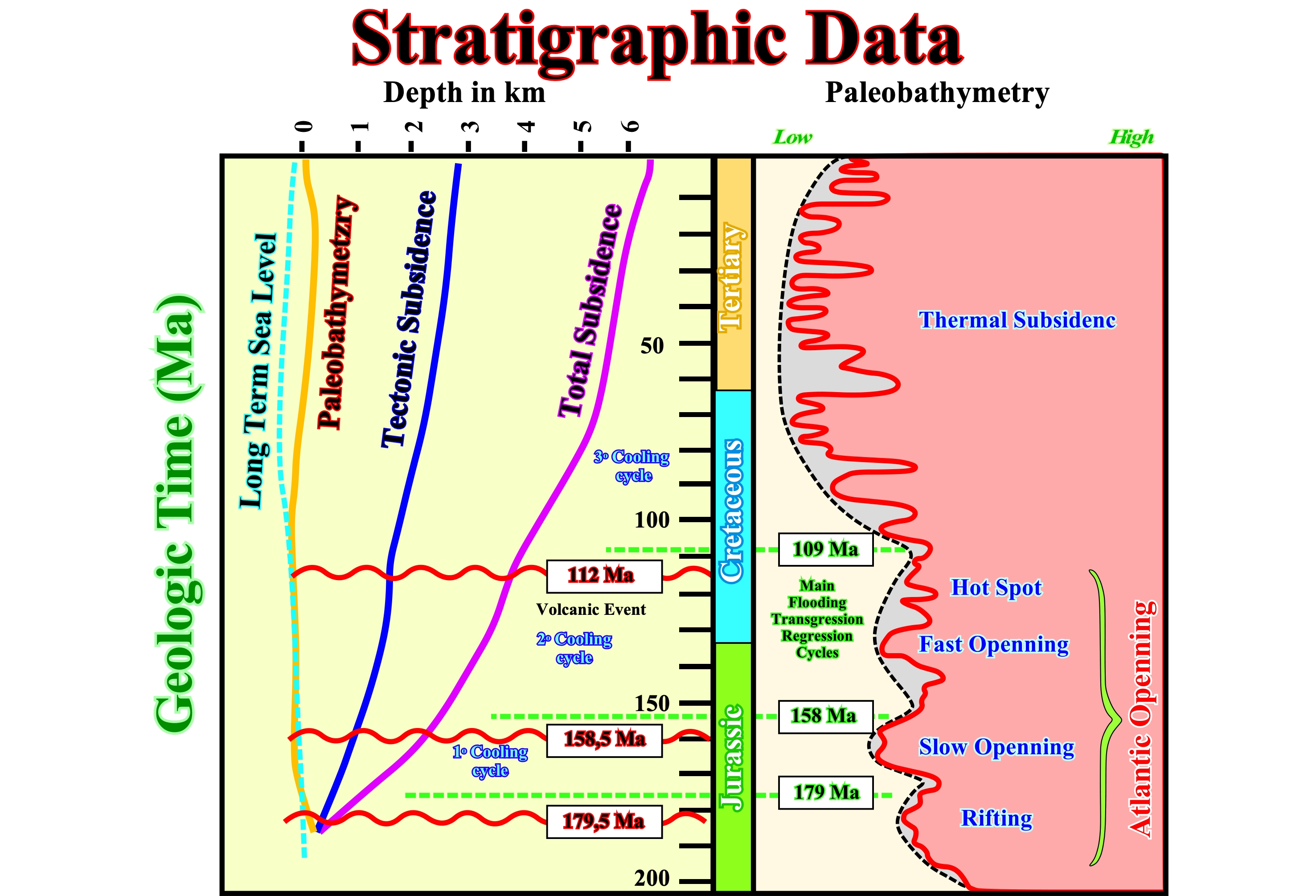

Subsidence & Accommodation
In a given area and in a certain geologic time, the subsidence and tectonic uplift are, directly, related to a characteristic tectonic regime. Assuming a constant absolute (eustatic) sea level, one can say :
1) During extensional tectonic regime (sedimentary lengthening) characterized by a maximum effective stress (σ1) vertical, the sediments are lengthened :
1.1)- Lengthening induce subsidence ;
1.2)- Subsidence induces a relative sea level rise, which increases the accommodation, i.e., the space available for sediments ;
1.3)- A relative sea level increase (RSLR), that is to say, a marine ingression induces deposition, during the stability period of the relative sea level that follows each increment of the relative sea level rise.2) During compressional tectonic regimes (sedimentary shortening) characterized by a maximum effective stress (σ1) horizontal, the sediments area shortened :
2.1)- A sedimentary shortening creates an uplift, which induces a relative sea level fall decreasing the accommodation ;
2.2) A relative sea level fall (RSLF) induces erosion, if the sediments are exposed to the erosive agents.
When tectonics is combined with eustatic changes, the final accommodation, i.e., the total space available for the sediments is the sum of the space induced by the tectonics and by absolute sea level changes:
- During an absolute sea level rise (increasing accommodation), the water-depth increasing created by the subsidence is added to that created by eustasy (absolute sea level changes) ;
- During an absolute sea level fall (decreasing accommodation), the decreasing space available for the sediments created by eustasy must be subtracted from the amount of space created by subsidence.
- In the case of an uplift (compressional tectonic regime), the reduction of accommodation is amplified by the reduction created by an absolute sea level fall and diminished by the accommodation created by an absolute sea level rise.

Figure 071- The combination of eustatism (absolute sea level changes) and subsidence (or uplift) controls the relative sea level changes. Landward of the shelf break, a relative sea level rise creates space available for the sediments (accommodation) favoring deposition. On the contrary, a relative sea level fall decrease the shelfal accommodation and favors erosion. Seaward of the shelf break, relative sea level changes have important sedimentary consequences, particular, when the relative sea level fall is significant and enough to create lowstand geologic conditions (sea level lower than the basin edge).
The tectonic has the big effect on the creation of space available for the sediments (accommodation). With the climate they control the type and quantity of sediments deposited. Tectonics has a great control on the stratigraphy. The tectonic events have signatures very characteristics. Taking into account the of magnitude and time duration of tectonic events, P. Vail distinguished three hierarchical levels of tectonic events with typical stratigraphic signatures :
A) Tectonic events with high level ;
B) Tectonic events with middle level ;
C) Tectonic events with low level.A) Tectonic events with high level, these tectonic events result from thermodynamic processus in Earth's crust and upper mantle. They are, directly, associated with Plate Tectonic mechanisms :
A.1) - Rifting (lengthening or extension) ;
A.2)- Seafloor Spreading ;
A.3)- Tectonic Sutures ;
A.4)- Thrusting (compression), etc.They area considered as belonging to long term hierarchical tectonic events. Their stratigraphic signature is the sedimentary basin, i.e., they are the principal cause of the sedimentary basins formation.
B) Tectonic events with middle level, these tectonic events occur during the evolution of the sedimentary basins, i.e., within a continental encroachment stratigraphic cycle. They can be recognized by the rate of subsidence's variations. They result from the reorganization of the tectonic plates or local thermodynamic anomalies. This class of tectonic events is characterized by a period of subsidence rates, relatively, high followed by a rate of subsidence, relatively, low. The stratigraphic signatures are the continental encrochment subcycles or the great transgression/regressions cycles. In other words, they area characterized by significative displacement of the shoreline downward and seaward.
C) Tectonic events with low level, these tectonic events with low level are the folding, faulting, diapirism and magmatic activity. The stratigraphic signatures are the dip and faulting of the strata, what often, can be recognized in the high level stratigraphic cycles (sequence-cycles and sequence-paracycles). They are, generally, associated to events penecontemporaneous as slumpings, turbidites, bentonites, extrusive flows and intrusive sills and dykes, etc.
"The hierarchical tectonic events can be easily recognized ..........Vail wrote............. in tectonic subsidence curves constructed by plotting the depth of the horizon, preferably the top basement, in a series of ages over time. When the total sinking is corrected by a local isostatic compensation and sediment compaction, the result is the tectonic subsidence curve. This curve suggests the water column that tectonic would created if there were no deposition of sediments. This is the curve used to calculate the rates and magnitudes of tectonic subsidence, assuming that an isostatic compensation and compaction occur instantly and do not affect the subsidence of the surface deposition. "
The tectonic subsidence of a basin, which evolved in extension (lengthening), as, rift-type basins and Atlantic or non-Atlantic-type divergent margins (Figure 072), show, typically, an inflexion, since the subsidence mechanism changes from a differential crustal extension (during the formation of rift-type basins) to a thermal cooling (during the evolution of the divergent margin).
As tectonic subsidence curves of the basins, that evolve under a tectonic regime in extension are characterized by an upward concave pattern. Generally, they show, at least, two patterns of a concave subsidence upward. One during the extension phase of the crust (formation of rift-type basins) and another during the thermal cooling phase (divergent margins). Additional concave upward patterns can be induced by other episodes of crustal extension and thermal disturbances.

Figure 072- The subsidence curves can be used to classify the sedimentary basins. Bally and Snelson (1980) used the type of subsidence to classify sedimentary basins. In extensional tectonic regimes, rifting is associated with a differential subsidence (rift-type basins), while a drifting (thermal subsidence) characterizes the divergent margins. In the continental margins, unconformities, i.e., the boundaries of stratigraphic cycles, when they are not tectonically enhanced, are, generally, difficult to highlight landward of the shelf break and in deep water. As illustrated in the right diagram (associated unconformities) the identification of incised valleys and submarine canyons (from stratal geometric relationships or seismic reflectors) is, by far, the most efficient method to identify cryptic unconformities.
The curve of tectonic subsidence during the evolution of a basin under a compressional tectonic regime (Figure 073) shows a typical flexural loading pattern, i.e., it is convex upward. The period of maximum thrust is, commonly, associated with the maximum subsidence because this is the time during which thrusting produce the maximum loading in edge of the foredeep. Various convex upward subsidence patterns, are, normally, present in the basin in compression, suggesting variations in the rate of thrusting movement. There may be a period of stability or uplifting between of the convex upward subsidence curves. The uplift may be due to heating of a depressed crust. Transpressional basins exhibit convex upward patterns similar to those induced by a flexural loading, suggesting a loading area adjacent to the basin.

Figure 073- Some basins were formed during an extensional regime, which changed over time to a compressional regime. This change will be reflected in subsidence curve of the basin, which show a concave pattern upward in the beginning and another convex pattern upward at the end. The tectonic subsidence curve a basin, normally, displays an extensional or compressional pattern. Changes in the type of basin are, generally, visible in the morphology of subsidence curve. The tectonic subsidence curve associated with each type of sedimentary basin reflects the subsidence history and, in principle, the stratigraphic signature of the first hierarchical level of tectonic events. Each upward concave or convex pattern in the tectonic subsidence curve is, usually, associated with the transgression-regression facies cycles. The cycles are the stratigraphic signature of the changes in the rate of tectonic subsidence and are considered as the signatures of middle level tectonic events. Folding and faulting occur during certain periods of tectonic subsidence curve depending on the type of structuration. In extensional environments, faulting is more active during crustal extension phase. In a compressional geological context, faulting is more active in maximum subsidence phase. Tectonic subsidence curve influences the tectonic events of lower level and can show a deviation pattern of regional subsidence. A tectonic subsidence curve made in a basin formed under a compressional regime will show a high that corresponds to the development of a structure that causes a flexural loading. This high will be superimposed on the regional curve, which will show a maximum subsidence at the corresponding time.
The identification of the unconformities (Figure 074) associated with extensional and compressional tectonic regimes is very different:
- In the extensional regimes, the unconformities, are, generally, cryptic, except in the the upper continental slope, near the shelf break (in basins with shelf) or near the continental shelf (basins without shelf), where, often, the erosion induced by submarine canyons allows to highlight the relative sea level falls responsible of erosional surfaces, i.e., the unconformities.
- In compressional tectonic regimes, the unconformities are, often, tectonically enhanced, as shown previously. The geometric relationships between the underlying and overlying chronostratigraphic lines to the unconformities, are more evident than in extensional regimes. The reinforcement of stratal or reflector terminations allows an easy identification of erosion surfaces (unconformities) and the lateral correlation, downdip, with the associated paraconformities.

Figure 074- This seismic line of the USA offshore, i.e., a seismic line from an Atlantic-type divergent margin deposited above a rift-type basin and volcanism (sub-aerial), associated with the break-up of the Gondwana lithosphere and oceanic volcanism that accompanied continental drifting, a volcanic intrusion reinforces, locally, a cryptic unconformity (eustatic unconformity). At the top of this line, a progradational interval corresponding to Cenozoic, is, often, used to illustrate the importance of eustatism (absolute sea level changes) in stratigraphy, since during this time the tectonic subsidence is practically nil. The basement and the sub-aerial volcanism, postdating the break lithosphere (SDRs) are quite high (seismically) in the eastern part of the line. They form the eastern boundary of the Triassic-Jurassic rift-type basin, which top is, easily, recognized in the central and western part of this line. A salt diapir appears to have used the fault plane, between the rift-type basin and the basement, to intrude, progressively, the upper sediments.
The results of scientific and petroleum exploration wells located not far from the preceding line, were used by Greenlee (1989) to calculate the eustatic fluctuations of stratigraphic data (Figure 075). Tectonic subsidence, total subsidence, paleobathymetry, long term sea level variations , as well as, most likely, subsidence mechanism proposed by Greenlee for this area are summarized in the figure below.

Figure 075- Using the results of the well COST B-2, Greenlee calculated the eustatic fluctuations from stratigraphic. The subsidence, paleobathymetry, long-term sea level and the most likely mechanisms of subsidence, were corroborated by the results of exploration wells drilled in the North Atlantic, which, strongly, suggest that the breakup of the lithosphere of Pangaea (end of rifting) occurred, more or less, 179 million years ago and that three thermal cooling cycles succeeded.
The curve of the total subsidence indicates the depth of the well bottom at any particular time. The decompaction of the sediments and the correction of local isostatic compensation allow the calculation of tectonic subsidence. To obtain accurate results, the subsidence curve should be corrected by the paleobathymetry and the reference point set up to the long-term sea-level curve. The flexural loading can, also, influence the tectonic subsidence curve (variation of thickness of the adjacent sedimentary units). To separate the tectonic of the eustatic effects, the obtained subsidence curve can be compared with the curves of subsidence calculated, theoretically, for different amounts of crustal stretching. From the difference between the corrected subsidence curve and the interpreted curve of subsidence thermo-tectonic, the first order eustatic cycle can be assessed.